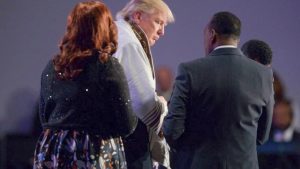The Trump Tallis and Outsider Journalism

Who’s more likely to get us wrong – journalists far removed from our community and its thought, or academic scholars outside their field of competence? The answer should be obvious: a journalist from outside the community, relying on an academic scholar. The Donald Trump Tallis Affair is just another case in point.
When a black pastor in Detroit draped a tallis around the shoulders of The Donald, Jewish tongues started clucking with disapproval. “Cultural appropriation!” “He’s an anti-Semite!” Notably, the vehemence, as best as I could tell, all came from Jews on the left – politically and religiously. Perhaps their real discomfort was in the realization that Donald Trump wears a tallis more often than they do. The rest of us were mildly amused (if anything about this strange campaign can be said to be amusing), and wanted to know more about the pastor and his church. (Hint: It is a Pentecostal church. There are lots of black Pentacostal churches, full of people who are pro-Israel, certainly more so than the elites in Haaretz who were quick to condemn the incident.)
The real cultural appropriation came from Jewish circles, which had to scramble to figure out what a tallis was, why the benighted religious Christians believed that Jesus wore one, and why they had to be wrong. Savor this, from an article in The Forward, authored by a “soferet” and designer of the famous Tefillin Barbie:
In the religion known as rabbinic Judaism, rectangular garments are required to have knotted tassels on the corners, following the Torah. According to the scholar Dafna Shlezinger-Katsman, in Jesus’s era, people in the eastern parts of the Roman Empire routinely wore a rectangular thing called a pallium, and therefore people who wanted to observe rabbinic Judaism probably put tassels on their pallia. …A tassel-equipped pallium is what the early rabbis were probably referring to when they said “tallit.” …The tassels on the religious Jews’ pallia probably stood out to those in the know, but those who weren’t savvy to the significance wouldn’t have cared especially…Jesus may or may not have worn a tallit, depending on whether he was the type who wore pallium and whether he was inspired to mark himself as part of the rabbinic in-group by attaching tassels to it. …Quite possibly Jesus, too, thought there were more important issues to focus on. …Having a special rectangular garment with tassels that you wear during prayer seems to have been a late medieval development, according to scholars like Elisheva Baumgarten.
Except that it wasn’t. Unless we assume that the Babylonian Talmud is of late medieval development. I can’t tell you how much a tassled Roman pallium would set you back on Ebay in fourth or fifth century Iraq, but they seemed to know about it and its role in davening:
R. Yochanan said, “Were a verse not written, it would be impossible to say it. This teaches that the Holy One, Blessed is He, wrapped Himself in a tallis like a prayer leader and demonstrated to Moses the order of prayer.” (Rosh Hashanah, 17B)



A few points:
1. R’ Yochanan lived in Israel, i.e., the Roman Empire, in about the year 250 CE. (Of course, there are scholars that claim that many of the statements in the Bavli weren’t made by those to whom their attributed, but they are generally ignored and it wouldn’t make much of a difference here anyway.) Probably by about his time is when you start seeing people no longer wearing four-cornered garments as a matter of course and thus beginning to wear a special tallit if necessary. The shift seems to have happened immediately based on this Gemara.
2. Luke 8:44 and Matthew 9:20 seem to imply that Jesus did indeed wear tzitzit if not an actual tallit.
The big question is whether he wore over or under his shirt. 🙂
This reminds me of the story of the apostate who wanted to bring proof from the Torah that one must wear a crucifix. He told the Rabbi that it says in Shma, וראיתם אותו. And that must refer to who is referred to as ״אותו״ האיש.
The Rabbi responded ״so what do you do with the Posuk ולכלב תשליכון אותו.
amongst the reasons the PC jewish left need ‘pray’ Trump isn’t elected is the prospect of a MO couple staying overnight in the white house , eating only kosher there. they would be much more comfortable with what is most common in their families— their son bringing over his Gentile wife…..
Do you think that she literally made this up? Or that she is a total ignoramus? Did you contact her to clarify? Given that it is her job to research medieval Jewish communities, it probably makes sense to read her charitably and to figure out how she would deal with the text from RH. Also potentially worth mentioning that the picture on the Hebrew U website indicates that she is frum.
Knowing more about the author, I would assume that most of the blame belongs there. The scholar in question does appear to be frum. I must confess, however, that there quite a few frum people who are unacquainted with Rosh Hashanah 17, and a few other dapim of Shas.
I have no particular skin in this game, but couldn’t one say that on the contrary, the gemara indicates that only the shaliach tzibbur wore a tallis, and the academic was referring to the custom of everyone wearing one?
Let’s backtrack. [Thanks to Richard as well, who commented similarly] The typically self-assured and typically wrong Forward journalist wrote: “But this kind of tallit, the tasselled pallium, is just like wearing a baseball cap with a slogan on it — it’s something you might routinely wear, adapted in a way your in-group cares about. It is not a ‘prayer shawl,’ a garment associated with worship services.” She used this to mock the pastor, and other conservative Christians who believe that their use of contemporary religious objects connects them to the Judaism of the time of Jesus. The issue is not whether a talis earmarked for davening was common at that time. It probably wasn’t, because people were wearing contemporary Roman garments like the pallium, which had four corners and therefore were obligated in the mitzvah of tzitzit which they (and Jesus, as pointed out by another commenter here!) observed. (Someone might want to explain what “mitzvah” means to the folks at the Forward. Hint – it means neither “good deed” nor “baseball cap.”) The passage I cited from Rosh Hashanah shows that an outer garment with tzitzis was assumed by the 4th century in Iraq (no, I don’t care if R Yochanan was from Israel – it is the Babylonian Talmud that is citing him!) to be important in the prayer service. Important enough that the prayer leader is depicted as wrapping (or covering) Himself in some sort of garment. I think it is reasonable to assume that the garment was not a pair of socks, and that it was integral to the prayer itself, or it is a detail that the author would not have mentioned. Call it what you will. (In rabbinic literature, an outer garment was called a tallis. See Bereishis Rabbah – that’s an early midrash, for the academic types – 36:4. For variants of “pallium” in rabbinic literature, see Kelim 29:1 and commentaries) The garment was very much associated with worship services, contrary to the Forward writer. When the pallium went out of style, its function had to be taken up by a special garment, worn only during davening. But that hardly detracts from the religious role of wrapping oneself in a garment, surrounding oneself with the tzitzis, as an early motif of prayer.
Lacosta, funny I know tons of MO people. None have gentile wives or daughters-in-law. How does a comment like that get posted on a moderated site?
You should all be ashamed!
Please reread his comment. He said exactly the opposite of what you thought. He wrote that non-frum, progressive Jews are not prepared for a Trump in the WH, because that would mean his kids – a MO couple would stay over, rather than the usual secular Jewish guests – who marry out at the rate of 71% UNLIKE Modern Orthodox Jews!
You say “Jewish tongues started clucking”. Which Jews? Not the ones I know. And in the media I read, this “story” didn’t even register. We as a community long ago matured past the point of worrying about media sources transparently hostile to orthodox Jews and orthodox Judaism. As the song goes, haters gonna hate. Let the Forward write a piece explaining why they thought communism and Yiddish would save the world, and whatever became of that mindset. Now that’s something I’d be interested to see.
Not sure that your position is universally subscribed to. Many people DO concern themselves with what the others say about us, because it directly impacts upon the way the world looks at us. Haaretz also targeted the pastor. Now, Haaretz is read by a shrinking population in Israel – but a large one outside of Israel. It is regarding – fittingly!- as the New York Times of Israel. Most folks I know share your position insofar as trying to change them. But ignoring what they say is not a prudent way to safeguard the interests of the Torah community.
I understand that point of view, but must respectfully disagree with it. Ignoring something very often is the best way to protect one’s self-interest. In fact, that’s exactly what the Agudah counseled in the 1950s vis-à-vis the Reform movement – ignoring it, rather than engaging or debating with it, which other organizations favored. And it worked (albeit with heavy losses in the Reform community.) By putting its head down and concentrating solely on itself, the community was able to blossom in both size and influence.
The influence of newspapers has waned, and this election cycle demonstrates that perfectly. Websites like the Drudge Report are read by millions more people. And Haaretz – advocates of a left wing government that has been out of power for a generation – is all but completely ignored. It is true that readers of a certain vintage will continue to read such papers (some only על מנת לקנטר) nor do I suggest they are completely devoid of any influence altogether. But their heyday is over. It was Johnson, I think, who said something about a fly being able to sting a horse, but one is still a fly, and the other is still a horse. We are now that horse, and need not and should not worry about silly things, like tallis controversys, that swarm constantly around us. We have bigger fish to fry.
If Trump said that the sun rises in the east, we’d see and hear a barrage of nonsense alleging racist implications. The information age has descended into mis- and disinformation thanks to the secular elite’s war on common sense.